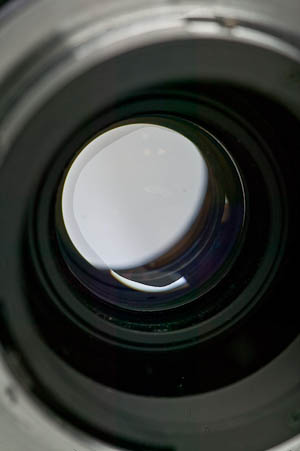
Tokina AT-X 28-85mm f3.5-4.5 The 99 cent lens. |
||
|---|---|---|
Specs:
|
 |
|
Cheaper than a cheesburger? That's a deal. It happens occassionally on ebay when no-one else bids on a lens with a starting price of $0.99. However, this was no lucky bid, as the sellers description read more like a buyer beware sign. Marketing has a lot to do with how a bidder perceives the actual worth of an item. For example: "Slight scratch, but not affecting pictures" is the same message as "front element is scratched". The former wording is well, more informing and thus likely to draw a higher bid, as the issue will not degrade the usefulness of the lens. In this case, "lens has seperation.." and "sold as-is for parts or repair." is also information, but obviously a message that scares many away. So, when I inspected the "seperation" as shown in the photo, I bid without hessitation. What is lens seperaration anyway? Lens seperation is when the adhesive bond between two lens elements begins to break down and seperate. this creates an air pocket or change in the surface of the lens within the effected area, and can lead to blurring or flare within the image.
In regards to lens seperation, if the seperation is upon of the edges of the lens, then it's still possible to use the lens so long as the seperation does not cross over into useable area of the lens. Especially when using crop sensor digital cameras, whose sensor area is less than full frame, and only use the middle portion of the lens. Will this lens seperate completely? Most likely, but not today, or in a year or two. Plenty of time to get my 99 cents worth out of it. Tokina was formed by a group of engineers whom defected from Nikon in the 1970's. Their AT-X line of lenses is considered their high quality line (much like Canon regards their "L" line of lenses). My test and sample images reveals this to be a good lens in both sharpness and color contrast. The only exception is when used wide open at f3.5 where the image is soft (good for portraits) and flares easily. Quality improves greatly at f5.6 and higher. Being a varifocal lens, one has to refocus the lens when zoomed, however the design allows for higher quality shots as it's behaves more like a prime lens. The lens also has a macro feature and it's not very useful, and best left to a dedicated macro lens anyway. I found the 28-85mm range a little short for most applications. However, on a 1.6x crop sensor camera, the range hits a 45-136mm, and it's a perfect fit for portraits. The lens also focuses with a few feet, and even when not using the macro feature, and is perfect for small items at arms reach. Focus is smooth and fast, and with good contrast, I can quickly hit focus on moving objects even with the not so great 40d stock matte screen. This lens is in OM mount, and I'm using it with an Olympus OM to EOS adaptor with focus confirmation chip. I don't need to see the AF light to know I have focus with this lens. The lens is cosmetically flawless, and both fit and finish are solid. I find this to be an exceptional lens, and in the final analysis, I would have paid $99 for it and considered it a bargain. It has found a home in the pelican case. 99 cents. What a steal. -Keep Shooting.
|
||




